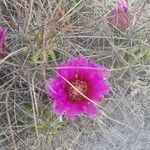Plants branched forming dense or lax clumps with 20-100(-500) branches, usually branching before flowering. Stems some-what lax often sprawling, longest stems sometimes prostrate, cylindric, 8-40(-100?) × 3.2-15 cm; ribs (6-)7-10(-12), crests essentially uninterrupted; areoles (11-)14-52 mm apart. Spines 6-14 per areole, straight or central spines slightly curved throughout their lengths, ± opaque, white, pale tan, or purplish gray, often extensively tipped or banded with brown; radial spines 5-10(-13) per areole, 9.5-40(-47) mm, usually less than 1/2 as long as central spines; central spines 1-4(-5) per areole, all or mostly projecting, abaxial spine porrect or descending, frequently compressed or angular in cross section (sometimes sulcate, keeled, or striate), (12-)20-84(-96) mm. Flowers (4.5-)5-7.5 × 5-5.6(-9) cm; flower tube 10-30 × 10-22(-40) mm; flower tube hairs 1-2 mm; inner tepals pink or magenta, darkest proximally, 28-55 × 8-14(-20) mm, tips relatively thin and delicate; anthers yellow; nectar chamber 4-6 mm. Fruits pale yellow-green or dull reddish, 20-30 mm, pulp white or pale pink. 2n = 22.
More
A cactus which forms clusters. It tends to lie over. The stems are 20 cm long and 3-7 cm wide. There are 8-10 blunt ribs. The spine spots are white and round. They are 1 cm apart. There are 7-10 spines which radiate out. These are white and 1.5 cm long. There are 1-3 spines in the centre and these are 4-6.5 cm long and yellowish-brown. The flowers are pale purplish-red. They are 5-6 cm long and about 7 cm across. The fruit are round with pink flesh and a strawberry taste.
Desert scrub and grasslands, on limestone soils, sometimes clay loam soils of rocky or gravelly hills, washes or plains in desert, brush/grassland.
More
It needs a sunny position. It needs a temperature above 10°C.


